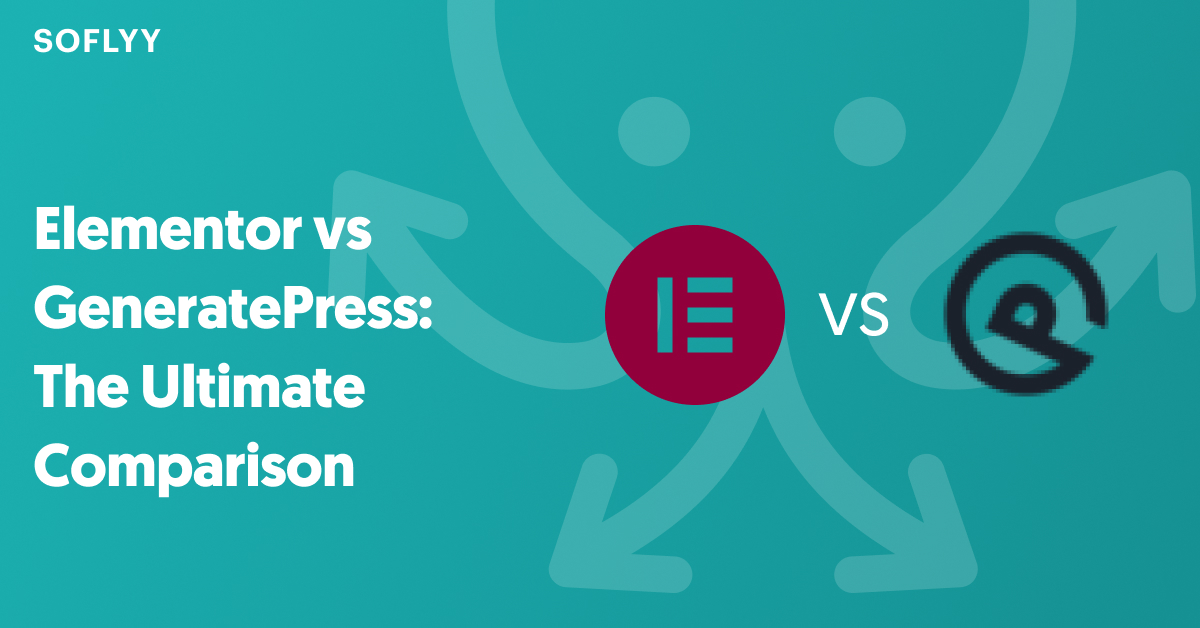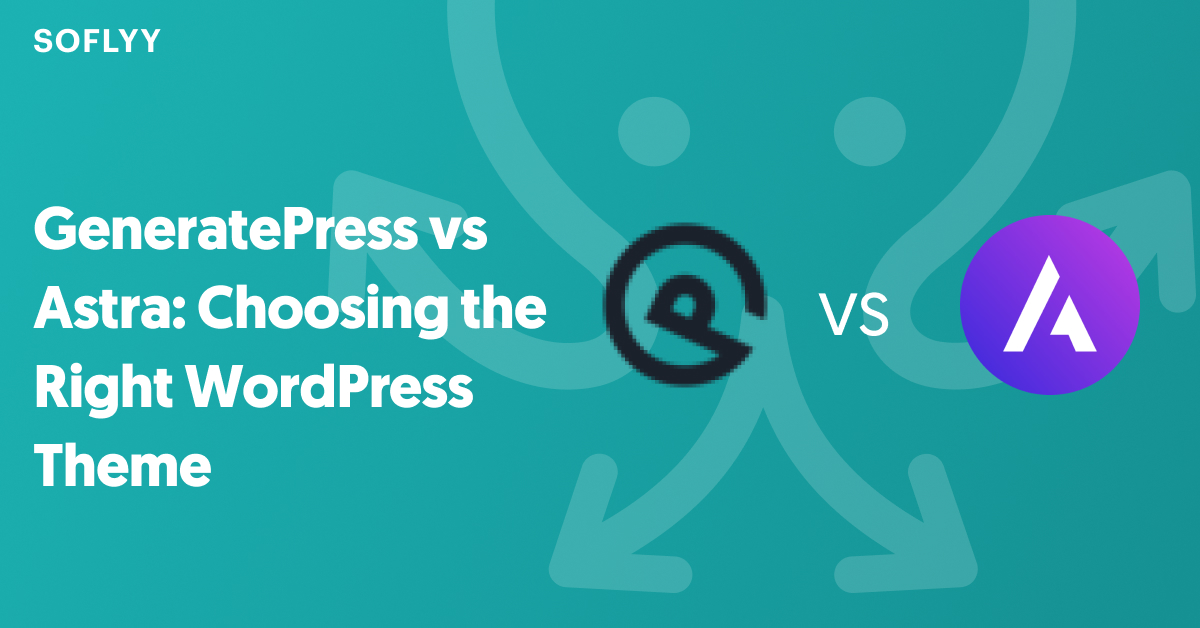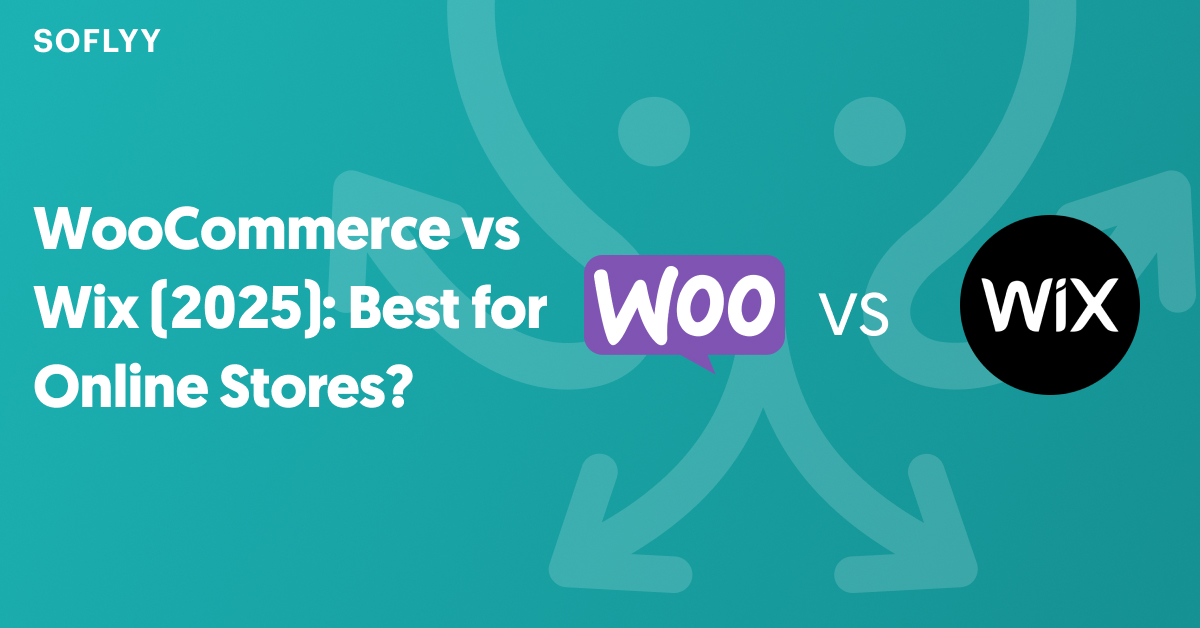WordPress theme builders are growing in popularity every year. Even WordPress itself introduced its own page builder, called the Block Editor, with a theme-builder functionality known as Full Site Editing (FSE.) This is essentially what theme builders have been offering for years, but using the Block Editor instead of a third-party tool.
There are lots of options if you’re looking for a WordPress theme builder. It’s easier than ever to find a capable tool to help you design your entire site.
In this article, we will look at the best WordPress theme builders to help you find the one that best suits your needs. These will be compared based on factors such as ease of use, features, and pricing so that you can make an informed decision on which one will work best for you.
Why Do You Need a WordPress Theme Builder?
To understand WordPress template builders, we have to look back at the history of themes in WordPress.
In the old days, WordPress design customizations were nearly always achieved by editing the theme – a set of template and CSS files that determined the way your site looked. Eventually, page builders emerged, allowing you to edit the content areas of your pages with a visual tool rather than by editing theme files.
Page builders eventually evolved into theme builders, meaning they allow you to edit parts of your site typically handled by the theme. This includes things that live outside of the content area, and therefore out of reach of pure “page builders”, such as the header, footer, sidebars. Theme builders also allow you to design templates visually, which are then applied to specific types of content based on rules you have defined in the theme builder. This opens the doors to custom designs for archives, single posts, 404 pages, search results pages, and more – all without duplicating your work needlessly.
By allowing you to create templates rather than just individual page content, theme builders enable the savvy WordPress designer to quickly build out an entire site by creating just a few designs that apply across every page or piece of content with specific criteria.
Here are some of the key benefits of using a WordPress theme builder.
- No Coding – This is why everyone, even experienced WordPress users, uses a theme builder. It makes it faster and easier than ever to build a good-looking website.
- Drag and Drop – Most theme builders have a drag-and-drop interface. If you want to move a section you created to the top of the page, you only have to drag it there. It’s as simple as that.
- Works on All Devices – Gone are the days when everyone viewed websites on a desktop computer. Most websites are now viewed on mobile phones or laptops, and these theme builders produce designs that work well across all devices.
- More Control – They just give you more flexibility over traditional landing page builders.
- Templates – A theme builder offers the ability to create designs for certain content such as single pages, archive pages, 404 pages, and others. These can easily be changed with minimal effort to ensure consistency, and reduce the amount of work required to build out a complete site.
- Post Loop Builders – Most WordPress theme builders also allow you to have precise control over the way your post loops – blog lists, custom post type lists, etc… – are displayed on the site.
Now that you know why you might need to take a closer look at WordPress theme builders, let’s talk more about one of the most powerful features of a WordPress theme builder: templating.
Custom Templates You Can Create With WordPress Theme Builder
One of the great features of WordPress theme builders is that you can create templates for pages or areas on your website that you can reuse for other pages. Old-fashioned themes often limit you to a predesigned layout, and to create a new layout you would need coding knowledge.
Some of the most common templates are:
- Blog posts – Generally, you want a uniform look for blog posts. With WordPress theme builders, you’re able to design one template that is used to render all blog posts, resulting in a more consistent look. If you want certain blog posts to look different, however, you can conditionally apply different templates to them based on categories, tags, and more.
- Product Pages – A great WordPress theme builder will allow you to create templates for custom post types as well, such as WooCommerce products. This gives you the same benefit as blog post templates, but applied to any post in your WordPress site, even non-standard ones.
- Header and Footers – Headers and Footers are, quintessentially, what makes a WordPress theme builder different than a WordPress page builder. By allowing you to design them, a theme builder gives you control over the entirety of your site rather than just the content area.
- Search Results Page – The Search Results page is often forgotten, but incredibly important. It’s the area used to display results when someone searches for content on your site. A great theme builder will allow you to customize this page as well.
- Archives – Last, but definitely not least, a great theme builder will allow you to create custom designs for any WordPress archive. Archives are used to display lists of posts, such as your blog post list, lists of products, and more. Without being able to apply templates to archives, a theme builder would be incomplete.
With a better understanding of the types of templates WordPress theme builders should be able to create, let’s dive into some of the best theme builders currently available.
7 Best WordPress Theme Builders to Create Custom Layouts
Since the advent of the classical page builder, many products have sprung up allowing you to customize your WordPress site. When it comes to WordPress theme builders, there’s certainly no shortage of options.
Here, we’ve selected the best WordPress theme builders that give you a variety of options and a glance at different approaches. Any of the options on this list will allow you to customize your site (and its theme), but not all are created equal. Let’s figure out which ones are the best.
1. Breakdance
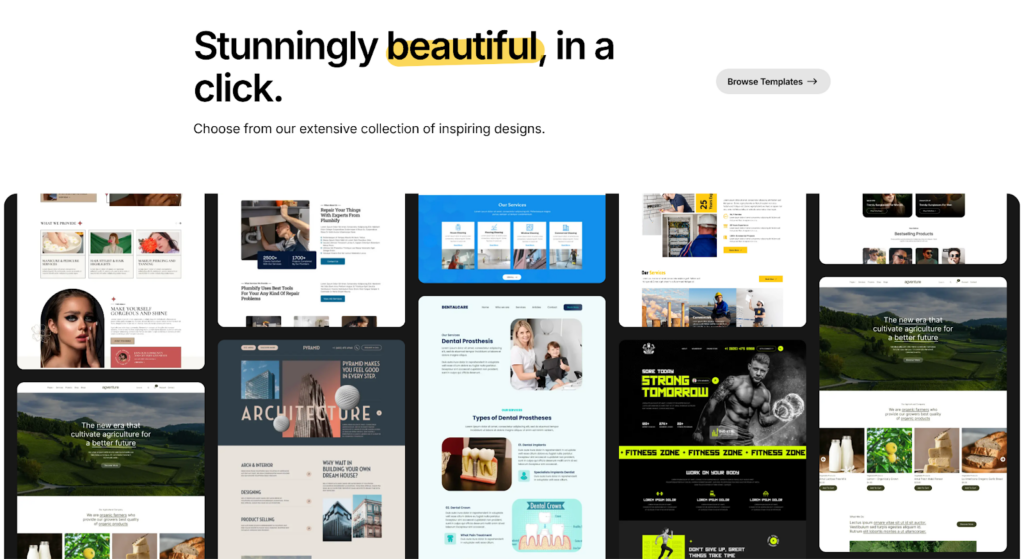
Breakdance is one of the newer contenders in the WordPress theme builder space, having launched in September of 2022. During its recent two-year birthday celebration, it was revealed that Breakdance now powers over 25,000 WordPress sites. That’s an impressive accomplishment for such a new offering, so let’s take a closer look to see why so many people are choosing to use it on their sites.

One of the main parts of Breakdance that you’ll encounter early on is its focus on Global Styles. Global Styles are similar to theme styles, and apply across your entire site. Where many page-builders-turned-theme-builder (e.g. Elementor, Beaver Builder, Divi Builder) have tacked on global styling to some extent, it’s clear that for Breakdance, global styles were a core feature from the very beginning.
Instead of designing each individual element, Breakdance allows you to set a shockingly large number of styles globally. These global styles apply everywhere on your site, meaning any element you drop in later will automatically match the global styles you set up. This is a huge time saver and helps you to build more consistent sites without fussing over individual styles on a per-element, or per-page basis.
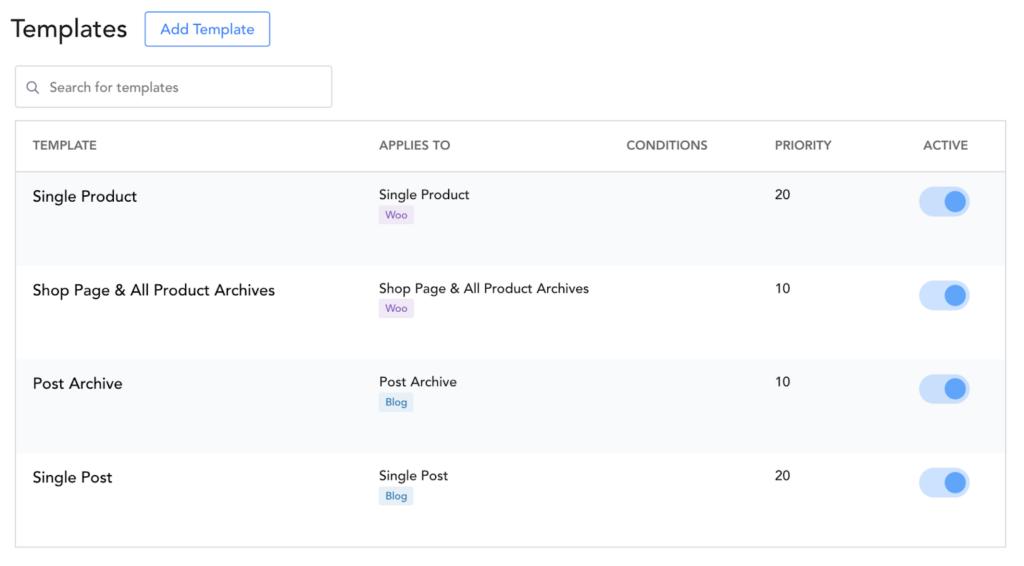
Breakdance also features an intuitive templating system, allowing you to create templates that apply to common areas and items on your site: 404 pages, search pages, headers, footers, individual posts, blog post index, and more. The easy location and condition options make it easy to fine tune where templates are used and ensure they’re shown only when appropriate. This configurability also makes it simple to apply different templates depending on certain criteria – such as a post’s category, or which page is being viewed.
Once upon a time, visual site builders, page builders, and WordPress theme builders were slow. Like, dropping right off the face of Google Pagespeed Insights slow. That all changed with the introduction of Oxygen Builder in 2016. By pushing the boundaries of the performance you could achieve with a no-code site building tool, Oxygen forced the industry to care about performance, and most modern WordPress theme builders achieve pretty good performance.
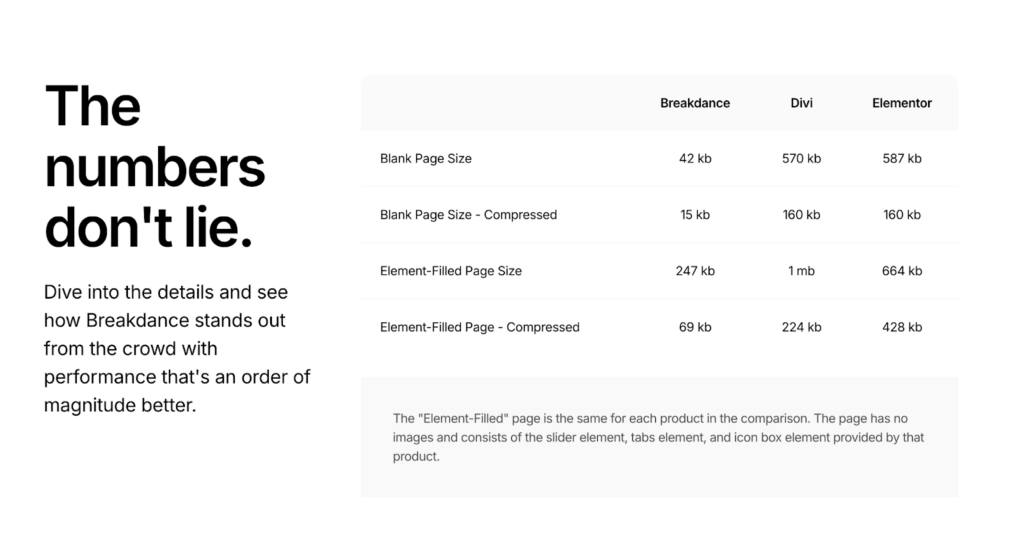
Breakdance, however, blows most of them away. While the old-school builders such as Elementor and Divi have made efforts to improve their performance, and succeeded in some cases, they just can’t compete with the newer technology that Breakdance is built on. Breakdance, rather than adding performance improvements as an afterthought, was architected from day 1 to be performant because nothing less is acceptable today.
This, of course, translates into SEO. While not everyone is looking to rank on Google for specific keywords, those who are need a WordPress theme builder that won’t get in the way. With clean HTML markup and good semantics, Breakdance opens the door and gives you the ability to work your SEO wizardry without bogging you down.
With all of these awesome advantages, you’d think Breakdance might be some high level developer-focused tool, but it’s not. The interface is built to be user friendly and familiar, enabling users of all skill levels to dive right in. Just below the surface, however, you’ll find all the power you need if you’re an advanced user or developer. It’s a truly remarkable blend of user-friendly and technically capable.
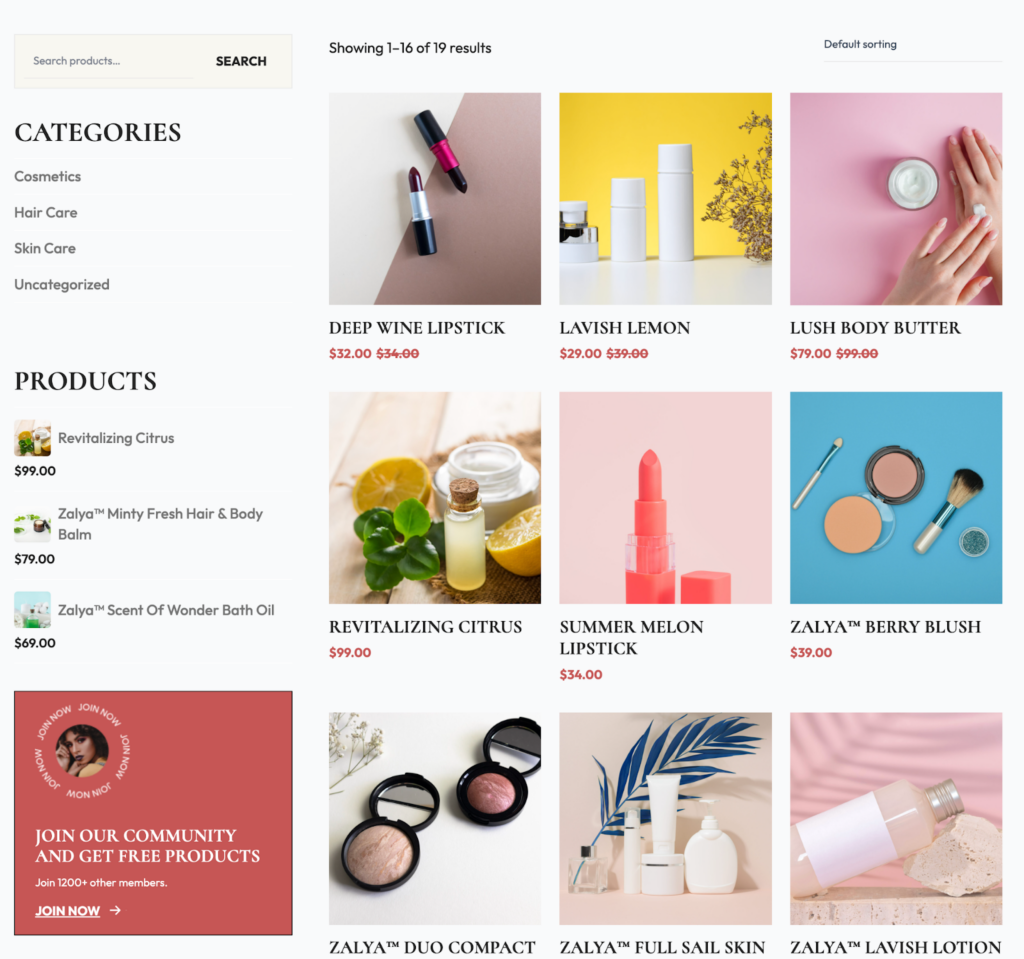
Finally, Breakdance has easily the best WooCommerce integration of any builder on this list. The completeness of the WooCommerce coverage in Breakdance from elements, to conditions, to even dedicated WooCommerce global styles is unheard of. If you’re building e-commerce stores, this is a huge benefit for you.
Here are a few other Breakdance features that we think are worth noting.
Breakdance Features We Liked
- Free version – There is a very capable free version, but you can upgrade to the Pro version if you want extra features.
- Clean Interface – Beginners won’t be scared, and experts will feel right at home with Breakdance’s modern interface.
- Big Element Library – Over 145 pre-built elements!
- Element Studio – This one’s a deep cut, but it’s incredibly unique. This feature allows you to build your own elements for Breakdance (or modify existing ones) without any code. Huge for agencies.
- Money Back Guarantee – Breakdance is one of the only builders to offer a 60 (that’s right, SIXTY) day money back guarantee. And they’re serious – they don’t ask any questions. Just email them and you’ll get your money back.
- Code Block – Breakdance is the only builder with a Code Block that lets you write PHP. Developers rejoice, you can build literally anything you can code right inside of Breakdance.
- WooCommerce Integration – I know we already mentioned this, but it’s truly remarkable. Turn your WooCommerce store into a Shopify-like experience almost instantly with Breakdance’s default WooCommerce styles and global styling controls.
Breakdance Features We Didn’t Like
- Limited Templates – It’s clear that the Breakdance team has taken a quality-over-quantity approach when it comes to pre-built design templates. There aren’t as many as some of the other builders offer, but the ones that are available are very high quality.
- Hidden Advanced Features – If you need advanced features, you may have to click a few times to get to them. Or you can use one of the many included keyboard shortcuts to eliminate the clicks and cut straight to the more obscure features. Most users won’t need these options, but if you do, it could take some time to adapt.
Breakdance Pricing
Breakdance offers a few different options that suit everyone. The free plan can be used on an unlimited number of websites which is a nice touch. If you need more features then the pro plan is $99.99 per year for one site or if you need more than one site, there is the pro unlimited plan at $199.99 a year.
2. Oxygen

Released in 2016, Oxygen’s launch marked the turning point for page builders as an industry. Because of its focus on lean, clean code output and incredible performance, most other page builders eventually focused a lot of effort on making their builders produce more performant sites as well.
Oxygen still fares very well, even against modern builders, because it is incredibly bare bones. It doesn’t come with very many opinionated default styles, and includes very few pre-built elements with complex structures. It does however, offer all of the fundamental HTML elements you’ll need to build virtually anything you want, all with visual CSS Flexbox and Grid controls.
With a clear focus on the developer crowd, Oxygen’s interface is more complicated. It has most of the CSS options you’d expect for a given element exposed by default, meaning you can have 1-to-1 control over the styles of elements without having to write the actual CSS. This is very intuitive if you already know CSS, but can be daunting if you’re not a coder.
Its Code Block is one of the best, further solidifying it as a great option for developers and highly technical users. With the ability to write CSS, HTML, JavaScript, and PHP directly inside of the builder, you’re only limited by your own ability to code. The code editor used for the Code Block and other areas is also highly polished, with some convenient features you’d normally expect to see in a dedicated IDE.
This WordPress theme builder also offers all of the theme building features you’d expect: full templating, some global styles, and the ability to apply designs to specific pages or areas of your site using a powerful suite of conditions.
Oxygen Features We Liked
- It Has An LTD – An LTD, or lifetime deal, means you can pay once and get to use Oxygen indefinitely with no recurring subscriptions. This can be a great value for some users.
- Great For Coders – Its coding-focused features are some of the best, from its Code Block to its external stylesheet editor.
- Super Lean – Oxygen doesn’t come with much baggage, meaning sites built with it are going to perform really well out of the box.
- Light On Opinionated Styles – This is both a pro and a con (see below), but if you’re looking for a super-bespoke style and don’t want any default styles to wrestle with, you’ll probably enjoy Oxygen’s approach.
Oxygen Features We Didn’t Like
- Learning Curve – Oxygen is a powerful tool, there’s no doubt. But with great power comes a fairly steep learning curve. Unless you’re a coder, prepare to spend some time learning your way around the tool at first.
- Light On Opinionated Styles – This has its upsides, but if you want something quick and easy, you’ll find you have to style most things from scratch in Oxygen. This can slow down the building process but does get you a more unique result in the end.
Oxygen Pricing
Oxygen starts at $129 for the basic plan, $149 for the WooCommerce plan and $179 for the Ultimate plan. All of these options include a lifetime, unlimited site license as of the writing of this article.
3. Beaver Builder
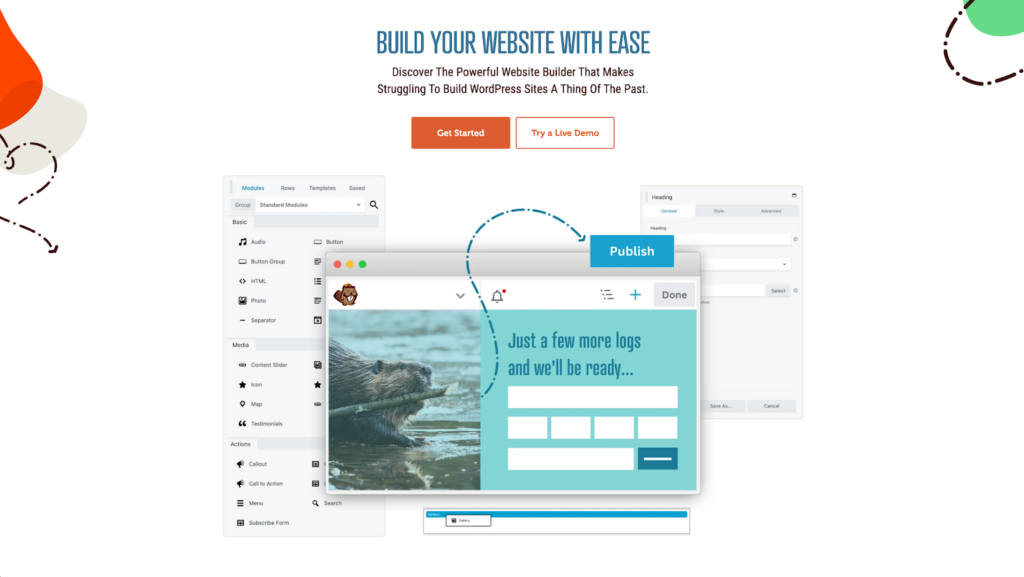
Beaver Builder is another WordPress theme builder in the old-school category. Originally, Beaver Builder was just a page builder, but it has evolved over the years to include some theme building capabilities. Of note, however, is that theme building isn’t included by default. You have to subscribe to Beaver Themer, a theme-building add-on, in order to unlock most of the critical features.
A solid option for those who value stability and slow, long-term feature growth, Beaver Builder has a reputation of being dependable. This means it’s lacking some important features, however, since it hasn’t made a huge effort to keep up with other builders in terms of feature parity.
The interface is a bit dated, a remnant of the early days of page builders, with floating toolbars and panels. If you’re used to modern tools, this may be slightly disconcerting.
With a limited number of templates and not too many native elements, Beaver Builder is similar to Oxygen in the sense that you’ll likely be building most designs from scratch. This can be OK if you’ve got plenty of time, but isn’t ideal for projects that need to get launched fast.
Beaver Builder Features We Liked
- Beaver Themer Conditions – Beaver Builder offers some nice element visibility conditions if you buy the extra Beaver Themer add-on.
- SEO-Friendly – Beaver Builder produces relatively SEO-friendly output.
- Popup Maker Integration – There’s no native popup builder, but Beaver Builder does have an integration with the Popup Maker plugin.
Beaver Builder Features We Didn’t Like
- Dated Interface – The interface style leaves a lot to be desired.
- Limited Pre-Made Design Templates – Beaver Builder doesn’t offer as many design templates as some of the other builders on this list.
- Theme Building Features Not Included By Default – It’s a pretty big setback that Beaver Builder doesn’t include theme builder options by default, and gates them behind an additional subscription.
- No Right Click Menu – This is more of an inconvenience, but can slow your workflow down a lot.
- Custom Post Loops Require Code – The Post List element offers a “custom” option for post layouts, but it requires that you write PHP code in order to customize it.
Beaver Builder Pricing
Beaver Builder starts at $99 a year for their standard plan. The Pro Plan is $199, which will suit freelancers, and it’s $399 if you want the Agency plan. The top package is the Ultimate plan, and that’s $546 for the year but does include the critical Beaver Themer add-on.
4. Elementor
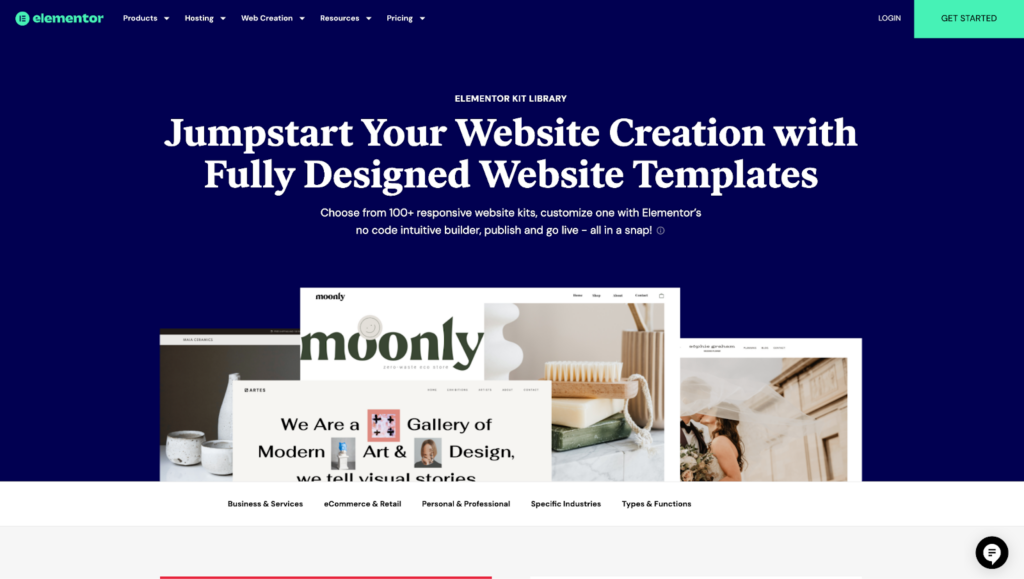
Elementor is one of the most well-known names in the WordPress theme builder space. It’s been around since approximately 2016 and has grown a lot since its early days.
While Elementor does offer many of the features you might seek in a theme builder, it also comes with the baggage of having been developed a long time ago. This means even the new features are resting upon dated, core code that has some notable implications.
Namely, performance. Elementor doesn’t generally perform well without some help. This means you’ll need excellent hosting, caching, and perhaps some additional performance plugins to ensure extra stuff isn’t loaded where it’s not needed.
When it comes to templating, Elementor offers plenty of options allowing you to create archive templates, 404 templates, headers, footers, and more. It does lack a bit in the area of conditions, which are logical rules that allow you to determine when a specific template is used. While Elementor offers conditional options for templates, you can only have a collection of AND rules, with no ability to create OR rules or combinations of both. This can be limiting for some use cases.
Elementor Features We Liked
- Modern Interface – Elementor’s interface has kept up with the times. If you’re used to modern tools, you’ll be mostly comfortable with its interface.
- Plenty Of Elements – This WordPress theme builder ships with plenty of useful native elements, keeping you from having to build everything from scratch.
- Decent Design Library – With 300+ pre-built templates, you’ll have plenty of options.
Elementor Features We Didn’t Like
- Performance – It’s really lacking by default, meaning you have to put in extra work to ace your Google Pagespeed Insights and GTMetrix scores.
- Limited Options – Elementor is positioned as a tool for beginners. This means you’ll find far more limited options for most settings.
- Very Few Global Styles – For a theme builder, Elementor lacks a number of global styling options that are available in other builders such as Breakdance.
Elementor Pricing
Elementor’s pricing is a little more convoluted because they offer hosting plans as well. For just the builder, it starts at $59 for 1 site. For 3 sites, you’ll pay $99. The 25-site plan is $199 and the 1000-site plan is $399. All of these prices are yearly.
5. Divi Builder
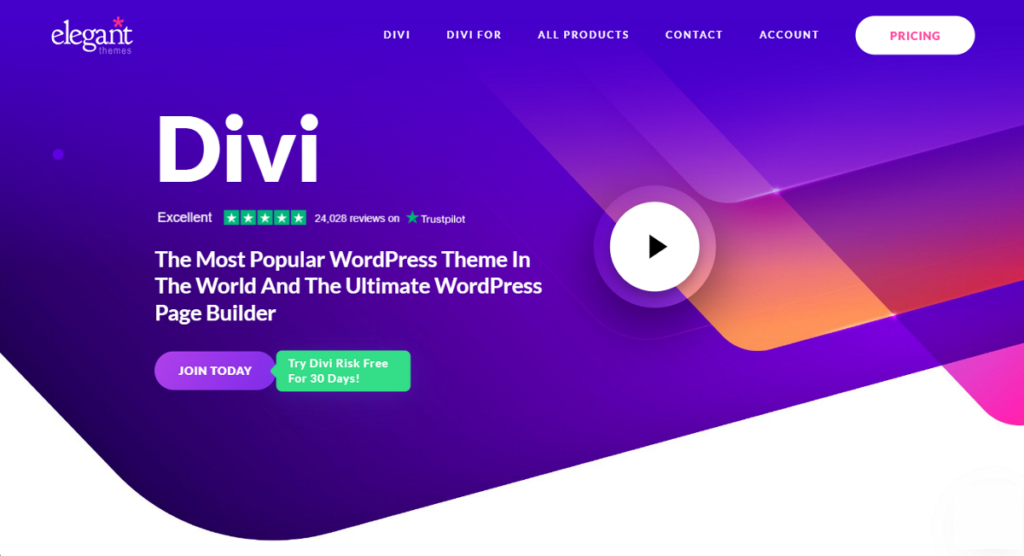
Divi is a popular WordPress theme builder as well, having been published approximately 3 years before the big page builder boom in 2016. This means it’s one of the oldest options on this list, and with that comes some important considerations.
One of the primary things that marks Divi as one of the more old-school options is its interface. It leans heavily on floating panels and floating toolbars, which can be a strange sight if you’re used to more modern tools with fixed panels. Whether you can get used to this or not is up to you, but it can be a bit of an adjustment if you’re not already familiar with the workflow.
As far as theme building features are concerned, Divi Builder has a fairly robust theme builder interface that allows you to create headers, footers, and many other types of templates. It has plenty of options that allow you to choose where your template applies.
One area where Divi stands out is its pre-made design templates. It has far more options than most of the other builders on this list, though not all of the pre-made templates are created equally as far as modernity and design are concerned.
Divi Builder Features We Liked
- Templating Options – The Divi theme builder interface is straightforward and offers plenty of template assignation options.
- Design Library – With a massive number of templates included, there are lots of options to choose from for any type of site.
Divi Builder Features We Didn’t Like
- Dated Interface – The Divi interface takes you back in time, and not in a fun nostalgic way.
- Limited Dynamic Data Options – If you’re looking to build more advanced, dynamic data powered sites, Divi has far fewer options than you’d expect.
- Very Basic Form Builder – Most sites need forms. With Divi, you’ll definitely need to reach for a third-party form builder if you want anything besides the basics.
Divi Builder Pricing
Divi Builder is $89 per year for the basic plan, and the Divi Pro plan is $277 per year.
6. Blocksy
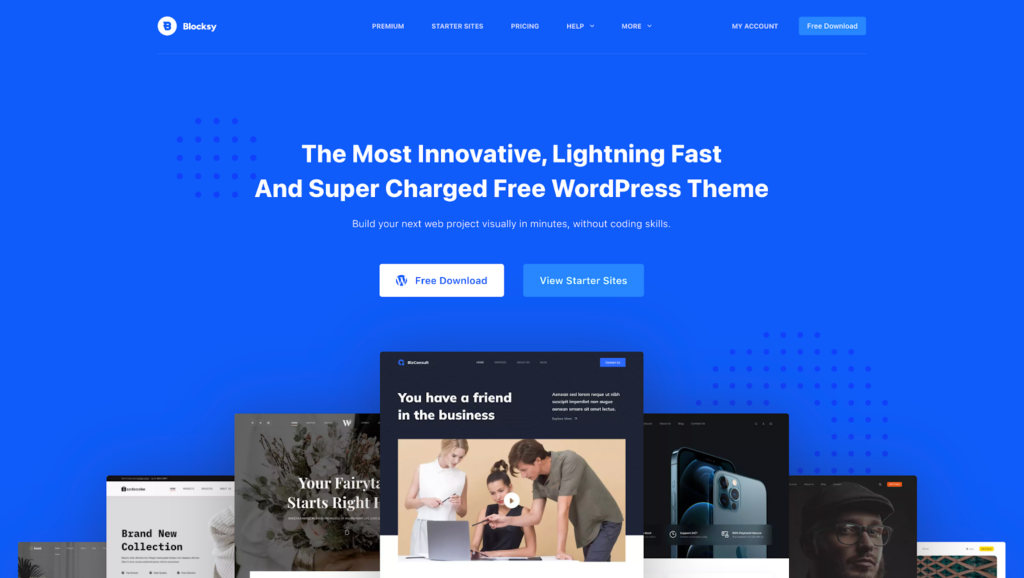
Blocksy is a bit different than the other WordPress theme builders on the list, being a theme itself. It does, however, offer customization options beyond a traditional theme, which is why we thought it would be interesting to take a look at its capabilities.
Blocksy comes with a Content Blocks template system that lets you easily create customized single and archive templates using in-house Gutenberg blocks. The available blocks are as extensive as those available with page builder, but they get the work done.
It also includes a Conditions Module that lets you select exactly where these templates apply to your website.
It has a decent number of attractive starter sites (some are even free!) that are relatively painless to import. In our tests, however, some of the starter sites required additional plugins that had to be auto-installed. With the age of bloated, plugin-laden sites slowly sinking below the horizon, it’s a bit unsettling to be prompted to install additional plugins in order to use the built-in starter site templates.
Blocksy Features We Liked
- Attractive Starter Sites – We counted approximately 37 starter sites. Most of them are limited to the Pro plan, but a number are available for the free version as well.
- WordPress Editor– As it’s Gutenberg block theme, things like post loops and archives are created using the same block editor interface. This means that users don’t have to learn a new interface to customize the theme pages.
Blocksy Features We Didn’t Like?
- Less Customization Options – With just a handful of FSE blocks, Blocksy provides limited controls to create a fully customizable website. This can be limiting if you need a bespoke design.
- Classic Theme = Customizer – You still have to use the dated Customizer to customize other parts of your website like global colors, typography, spacing and more.
- It’s A Theme – Unlike Breakdance and Oxygen, both of which act as themeless page builders to eliminate unnecessary overhead, Blocksy is a theme, which means dealing with child theming and other quirks that come along with that.
Blocksy Pricing
Blocksy has 3 plans. The personal is $69 a year for 1 site, professional is $99 a year for 10 sites, and the agency plan is $149 a year for unlimited sites.
7. Kadence Theme

Kadence is a popular multipurpose choice that is available in both free and premium versions. The free version will have enough flexibility for those who are creating a basic site. The pro version, when coupled with Kadence Blocks, essentially turns Gutenberg (the Block Editor) into a more full-featured WordPress theme builder.
It has a good selection of themes to choose from which will expedite your design process.
One of the major problems with Kadence, however, is that it is an add-on for Gutenberg rather than its own stand-alone page builder. This can result in some confusion as to whether Gutenberg is your page builder or Kadence is your page builder, since Kadence couldn’t do what it does without leaning on the Gutenberg interface.
Kadance Theme Features We Liked
- Good Starter Template Library – Kadence Theme offers plenty of options for quick, easy designs that can be imported as a starting point.
- Performance – Kadence does pre-load critical CSS to help improve performance.
Kadance Theme Features We Didn’t Like
- It’s A Theme – We prefer builders that give you complete control without needing a traditional theme.
- Popups Required Paid Add-on – There’s no built-in popup builder (an important option for sales pages). You have to buy a paid add-on to get this feature.
- It Leans On Gutenberg – A reliance on Gutenberg (the Block Editor) may end up encumbering Kadence over the long haul. After all, it’s built on top of its own competitor.
Kadence Pricing
Kadence has three options, all of which are for unlimited sites. There is the free version, the essential bundle at $149 per year, and the full bundle for $219.
Which Is the Best WordPress Theme Builder?
There’s a lot to consider when choosing a WordPress theme builder: from templating, to dynamic data, pre-built designs, and more.
After a deeper look at all the WordPress theme builder options on this list, the one that comes out ahead has the best blend of user-friendliness, advanced features, pre-built designs, and templating options: Breakdance.
This builder is a clear result of more modern technology and sleeker architecture, offering both stellar performance and a clean interface while still packing plenty of power for the advanced WordPress user.
With a focus on templating and the ability to go completely themeless, Breakdance is going to give you more exact control over your theme while remaining very performant with little work or extra plugins required.
As a runner-up, Oxygen is also worth considering for its lean approach and developer-friendly angle. If you like to write code, it’s a viable option that gives you all of the tools you’ll need while requiring a bit more of an investment in learning up front.
WordPress Theme Builders – FAQs
A theme builder is a tool that allows you to visually design and customize all parts of your WordPress website, not just the content areas. This includes templates like headers, footers, sidebars, and even templates for blog posts, product pages, and archive pages.
Breakdance stands out as the best overall WordPress theme builder. It offers a great balance of user-friendliness, advanced features, pre-built designs, and excellent performance. For developers, Oxygen is a strong runner-up due to its lean code and coding-focused features.
It varies greatly. Using a page builder like Breakdance or Oxygen is the most affordable (a few hundred dollars per year). This gives you complete control with a drag-and-drop editor.
